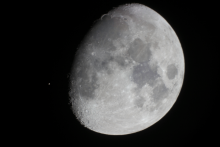Listen to today's episode of StarDate on the web the same day it airs in high-quality streaming audio without any extra ads or announcements. Choose a $8 one-month pass, or listen every day for a year for just $30.
You are here
Moon and Aldebaran
The Moon looks down on the eye of the bull tonight. Aldebaran, the brightest star of Taurus, is below the Moon as night falls, and to the left or lower left of the Moon as they set, in the wee hours of the morning.
It might be hard to notice through the glare of the Moon, but Aldebaran shines bright orange. The color is an indication of its surface temperature, which is much lower than the surface of the Sun. Because of that, Aldebaran is designated as a class “K” star.
Astronomers use seven letters to classify stars — O, B, A, F, G, K, and M.
O stars are the hottest. They blaze tens of thousands of degrees hotter than the Sun, so they shine blue-white. They’re also among the biggest, heaviest, and brightest of all stars.
At the other end are the M stars, which are the coolest. They look orange or red. Almost all M stars are so small and faint that they’re invisible to the unaided eye. The only ones we can see are bloated and bright — stars that have swelled to giant proportions at the ends of their lives.
The Sun is class G. It’s bigger and heavier than most stars, but nowhere near the monsters at the top of the scale.
As it nears the end of its life, though, the Sun will look much like Aldebaran does today — a bloated orange giant, designated as class K or M — at the red end of the stellar classification system.
Tomorrow: A planet with double sunrises and sunsets.
Script by Damond Benningfield




